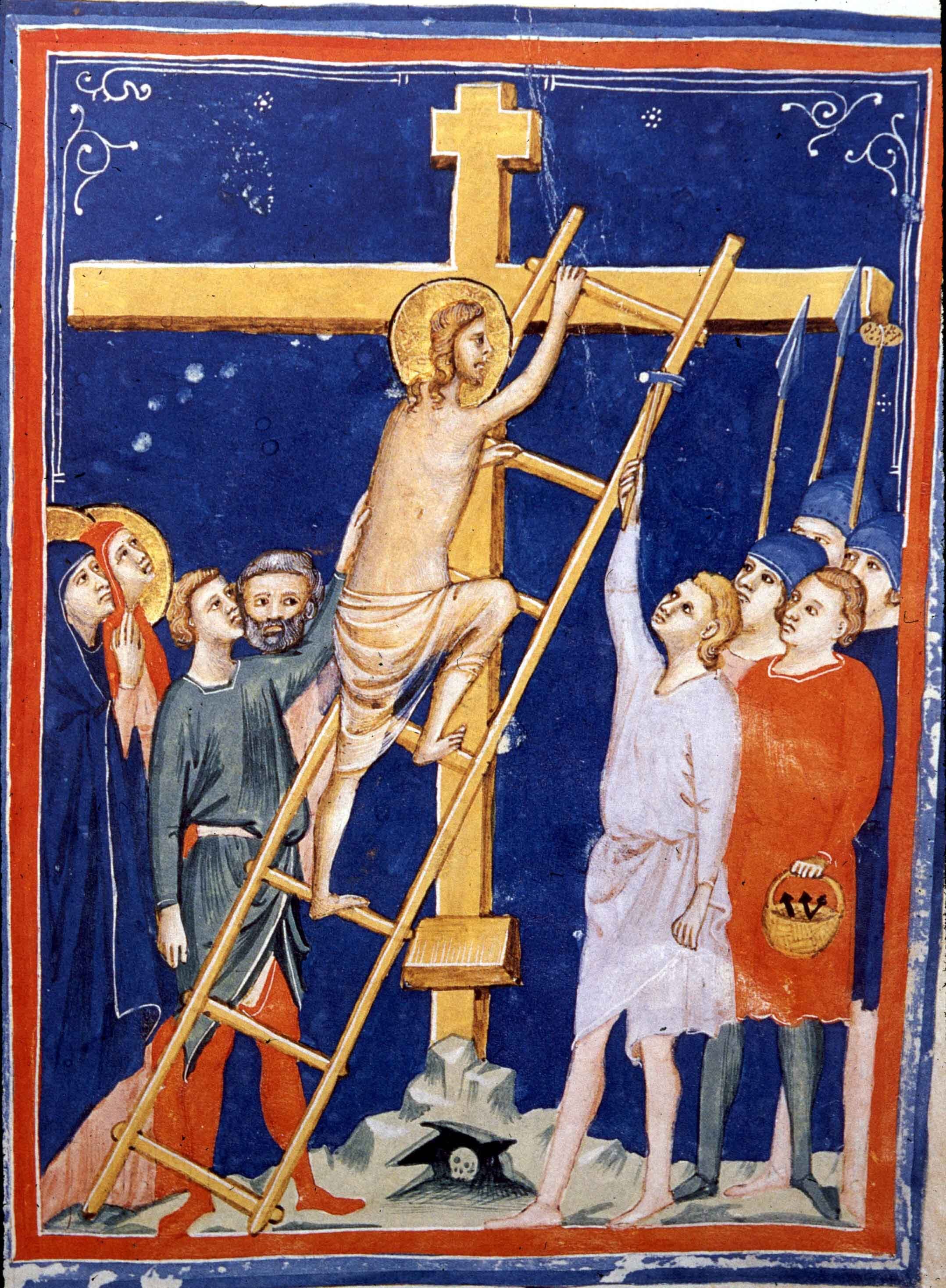A few years ago I climbed the scaffolding against the west end of the church. It was only 30 feet up or so. But I had to climb the ladder integrated into the scaffolding, and then squeeze between and under the railing to get up there. When I arrived I was proud of my self. Prouder still when the mason looked at me and said, “Father, I gotta give you credit, most people don’t come up here.”
I have also climbed a ladder up to nearly the top of of the inside of the tower of Saint Mark’s, maybe just 10 feet below the tippy top of the tower.
I am thinking about ladders. Sometimes a ladder is an important symbol or image. I think of Jacob’s ladder. Curiously, in his dream , Jacob didn’t have to dream about growing wings to fly up to heaven. He didn’t have to become like the angels. He could just be himself. All he had to dream about was a ladder. Nothing about him had to change. All he needed was a ladder to get to heaven.
There is a ladder implied in the Passion narrative. Most often we imagine it as part of the Deposition of Christ’s body from the Cross. We picture a ladder set up against the Cross so that the Roman functionaries, aided, perhaps by Joseph of Arimathea’s men, or by one or two of Jesus’ other disciples, in order to lower Jesus’ lifeless body from the Cross.
It’s one of the often depicted symbols of the Passion, along with the pincers, the spear, the sponge, the nails, the hammer.
But sometimes we find in art another version of the ladder set up against the Cross. In these rarer instances, the ladder is used by Jesus himself in oder to ascend to the Cross. In Christian iconography the image is referred to as Christ Mounting the Cross.
I have an image here of Jesus using a ladder to ascend to his own Crucifixion, to take his place on the Cross. And in this image you can see some of the figures in the crowd standing by. You can see Mary, along with some of the other women, and maybe some of the other disciples. You can see a man standing there with a basket holding the nails to nail Jesus to the Cross. And there is a man standing there, holding his arm up to Jesus, lifting up the hammer, to hand it to Jesus. The image suggests that not only will Jesus climb up to the Cross himself, he will nail himself to it as well. It’s a striking image.
Sometimes in these images, there is another person up on the crossbeam of the Cross, to assist Jesus once he gets there. A Roman functionary, I guess.
The obvious message of an image like this is that Jesus goes willingly, voluntarily to his death.
But at a time when nearly 100,000 people around the globe have died in the past months of a pandemic, thinking about Jesus going to his death is poignant, because his death always has something to say about our death.
Jesus goes to his Cross because that’s where his work of salvation is going to be done. On the Cross is where, by dying, Jesus is going to defeat death. On the Cross is where Jesus is going to shed his blood, which somehow mystically becomes the lifeblood of the world. He hangs himself there almost like blood drip hanging above a hospital bed, as though his blood is going to drip into our veins and make us better.
Jesus climbs up to his death in order to rob our deaths of their sting. Go ahead, he says, hand me the hammer and the nails, as if to show us that he has mastered pain and misery too.
Like Jacob, Jesus doesn’t need to change anything about himself to go up his ladder to the Cross. He goes just as he is, in all his humanity and in all his divinity.
In those images where there is a second person up on the Cross to assist Jesus when he gets to the top of the ladder, I imagine a very odd conversation taking place between the two. I imagine that functionary up there looking at Jesus and saying to hi, “I gotta give you credit, Jesus, most people don’t come up here on their own.”
No, no one goes to death on their own. That’s why Jesus went up his Cross to his death: a painful, shameful, and ignominious death, a deaths bad as any death. Only Jesus has clibmed the ladder of death alone. And because he has climbed it no one else ever has to. Only Jesus goes to death alone. For the rest of us, he is already there, to go with us. And no else every has had to go alone, and no one else ever will.
Notes for a sermon preached by Fr. Sean Mullen
Good Friday, 2020
Saint Mark’s Church, Locust Street, Philadelphia


